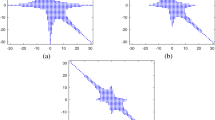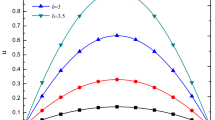Abstract
In this paper, we address the study of elliptic boundary value problems in presence of a boundary condition of integral type (IBC) where the potential is an unknown constant and the flux (the integral of the flux density) over a portion of the boundary is given by a value or a coupling condition. We first motivate our work with realistic examples from nano-electronics, high field magnets and ophthalmology. We then define a general framework stemming from the Hybridizable Discontinuous Galerkin method that accounts naturally for the IBC and we provide a complete analysis at continuous and discrete levels. The implementation in the Feel++framework is then detailed and the convergence and scalability properties are verified. Finally, numerical experiments performed on the real-life motivating applications are used to illustrate our methodology.
















Similar content being viewed by others
Data Availability
Data and meshes for the thermoelectric application are not open: the exact material specifications and geometries are secrets due to the high international competition between USA, Europe, China, Korea and Japan. However close enough models and the software configuration are openly available on Feel++GitHub repository, see https://github.com/feelpp/feelpp/tree/develop/toolboxes/thermoelectric/cases/ElectroMagnets. The data of the other two applications are openly available in Feel++repository (https://github.com/feelpp/feelpp).
References
2015 International Technology Roadmap for Semiconductors (2016). http://www.itrs2.net/itrs-reports.html
Arnold, D., Brezzi, F.: Mixed and nonconforming finite element methods: implementation, postprocessing and error estimates. Math. Model. Numer. Anal. 19(1), 7–32 (1985)
Carichino, L., Guidoboni, G., Szopos, M.: Energy-based operator splitting approach for the time discretization of coupled systems of partial and ordinary differential equations for fluid flows: the Stokes case. J. Comput. Phys. 364, 235–256 (2018)
Carichino, L., Guidoboni, G., Szopos, M.: Second-order time accuracy for coupled lumped and distributed fluid flow problems via operator splitting: a numerical investigation. In: Numerical Mathematics and Advanced Applications ENUMATH 2019, pp. 959–967. Springer, Berlin (2021)
Causin, P., Sacco, R.: A discontinuous Petrov–Galerkin method with Lagrangian multipliers for second order elliptic problems. SIAM J. Numer. Anal. 43(1), 280–302 (2005)
Causin, P., Guidoboni, G., Harris, A., Prada, D., Sacco, R., Terragni, S.: A poroelastic model for the perfusion of the lamina cribrosa in the optic nerve head. Math. Biosci. 257, 33–41 (2014)
Cockburn, B.: The hybridizable discontinuous Galerkin methods. In: Proceedings of the International Congress of Mathematicians 2010 (ICM 2010) (In 4 Volumes) Vol. I: Plenary Lectures and Ceremonies Vols. II–IV: Invited Lectures, pp. 2749–2775. World Scientific (2010)
Cockburn, B.: Static condensation, hybridization, and the devising of the HDG methods. In: Building Bridges: Connections and Challenges in Modern Approaches to Numerical Partial Differential Equations, pp. 129–177. Springer, Berlin (2016)
Cockburn, B., Dong, B., Guzmán, J.: A superconvergent LDG-hybridizable Galerkin method for second-order elliptic problems. Math. Comput. 77(264), 1887–1916 (2008)
Cockburn, B., Dong, B., Guzmán, J., Restelli, M., Sacco, R.: A hybridizable Discontinuous Galerkin method for steady-state convection–diffusion–reaction problems. SIAM J. Sci. Comput. 31(5), 3827–3846 (2009)
Cockburn, B., Gopalakrishnan, J., Lazarov, R.: Unified hybridization of discontinuous Galerkin, mixed, and continuous Galerkin methods for second order elliptic problems. SIAM J. Numer. Anal. 47(2), 1319–1365 (2009)
Cockburn, B., Guzmán, J., Wang, H.: Superconvergent discontinuous Galerkin methods for second-order elliptic problems. Math. Comput. 78(265), 1–24 (2009)
Colburn, A.: A method of correlating forced convection heat transfer data and a comparison with fluid friction. Trans. AIChE 29, 174–210 (1933)
Daversin, C., Prud’homme, C., Trophime, C.: Full three-dimensional multiphysics model of high-field polyhelices magnets. IEEE Trans. Appl. Supercond. 26(5) (2016)
Daversin, C.: Reduced basis method applied to large non-linear multi-physics problems: application to high field magnets design. Ph.D. thesis, Université de Strasbourg (2016)
de Veubeke, B.M.F.: Displacement and equilibrium models in the finite element method. In: Zienkiewicz, O., Holister, G. (eds.) Stress Analysis, pp. 145–197. John Wiley & Sons, New York (1965)
Dittus, F., Boelter, L.: Heat transfer in automobile radiators of the tubular type. Int. Commun. Heat Mass Transf. 12(1), 3–22 (1985)
Formaggia, L., Quarteroni, A., Veneziani, A.: Cardiovascular Mathematics: Modeling and Simulation of the Circulatory System, vol. 1. Springer, Berlin (2010)
Glowinski, R.: Finite element methods for incompressible viscous flow. Handb. Numer. Anal. 9, 3–1176 (2003)
Grisvard, P.: Elliptic Problems in Non Smooth Domains. Monographs and Studies in Mathematics, vol. 24. Pitman, London (1985)
Gröger, K.: A \(w^{1, p}\)-estimate for solutions to mixed boundary value problems for second order elliptic differential equations. Math. Ann. 283, 679–687 (1989)
Harris, A., Kagemann, L., Ehrlich, R., Rospigliosi, C., Moore, D., Siesky, B.: Measuring and interpreting ocular blood flow and metabolism in glaucoma. Can. J. Ophthalmol. 43(3), 328–336 (2008)
Harris, A., Guidoboni, G., Siesky, B., Mathew, S., Verticchio-Vercellin, A., Rowe, L., Arciero, J.: Ocular blood flow as a clinical observation: value, limitations and data analysis. Prog. Retin. Eye Res. 78(100841) (2020)
Hild, R.: Optimization and control of high fields magnets. Theses, Université de Strasbourg (2020). https://tel.archives-ouvertes.fr/tel-03025312
Jackson, J.D.: Classical Electrodynamics, 3rd edn. Wiley, London (1998)
Karypis, G., Kumar, V.: MeTis: Unstructured Graph Partitioning and Sparse Matrix Ordering System, Version 4.0. http://www.cs.umn.edu/~metis (2009)
Kirby, R.M., Sherwin, S.J., Cockburn, B.: To CG or to HDG: a comparative study. J. Sci. Comput. 51(1), 183–212 (2012)
Leske, M.C.: Open-angle glaucoma-an epidemiologic overview. Ophthalmic Epidemiol. 14(4), 166–172 (2007)
Markowich, P., Ringhofer, C., Schmeiser, C.: Semiconductor Equations. Springer, Berlin (1990)
Montgomery, D.: Solenoid Magnet Design: The Magnetic and Mechanical Aspects of Resistive and Superconducting Systems. Wiley-Interscience (1969). https://books.google.fr/books?id=D1138LYUoXAC
Muller, R., Kamins, T., Chan, M.: Device Electronics for Integrated Circuits. Wiley, London (2003). https://books.google.it/books?id=x64knwEACAAJ
Nicolaides, R.: Existence, uniqueness and approximation for generalized saddle point problems. SIAM J. Numer. Anal. 19(2), 349–357 (1982)
Prud’homme, C., Chabannes, V., Doyeux, V., Ismail, M., Samake, A., Pena, G.: Feel++: a computational framework for Galerkin methods and advanced numerical methods. ESAIM Proc. 38, 429–455 (2012)
Quarteroni, A., Valli, A.: Numerical Approximation of Partial Differential Equations. Lecture Notes in Mathematics. Springer, Berlin (1994). https://books.google.it/books?id=MB23keacoWMC
Sala, L.: Mathematical modelling and simulation of ocular blood flows and their interactions. Ph.D. thesis, Université de Strasbourg (2019). https://tel.archives-ouvertes.fr/tel-02284233/file/Sala_Lorenzo_2019_ED269.pdf
Sala, L., Prud’Homme, C., Prada, D., Salerni, F., Trophime, C., Chabannes, V., Szopos, M., Repetto, R., Bertoluzza, S., Sacco, R., et al.: Patient-specific virtual simulator of tissue perfusion in the lamina cribrosa. Invest. Ophthalmol. Vis. Sci., p. 727 (2017)
Sala, L., Prud’Homme, C., Guidoboni, G., Szopos, M.: Ocular mathematical virtual simulator: a hemodynamical and biomechanical study towards clinical applications. J. Coupled Syst. Multiscale Dyn. 6(3), 241–247 (2018)
Selberherr, S.: Analysis and Simulation of Semiconductor Devices. Springer, Berlin (1984)
Silberberg, Y., Lahini, Y., Bromberg, Y., Small, E., Morandotti, R.: Universal correlations in a nonlinear periodic 1D system. Phys. Rev. Lett. 102(23) (2009)
Acknowledgements
Christophe Prud’homme, Romain Hild and Lorenzo Sala wish to thank Vincent Chabannes from Cemosis for many fruitful discussions. The authors wish to acknowledge the Labex IRMIA from University of Strasbourg for supporting the Eye2Brain project. The PhD thesis of Romain Hild has been also supported by the Labex IRMIA.
Funding
Giovanna Guidoboni, Christophe Prud’homme, Lorenzo Sala and Marcela Szopos acknowledge the funding from the European Union’s Horizon 2020 research and innovation program under grant agreement No 731063. Giovanna Guidoboni has been partially supported by NSF-DMS 1853222/2021192. She also would like to disclose that she has received remuneration for serving as a consultant for Foresite healthcare LLC.
Author information
Authors and Affiliations
Corresponding author
Ethics declarations
Conflict of interest
The authors have not disclosed any conflict of interest.
Additional information
Publisher's Note
Springer Nature remains neutral with regard to jurisdictional claims in published maps and institutional affiliations.
Rights and permissions
Springer Nature or its licensor (e.g. a society or other partner) holds exclusive rights to this article under a publishing agreement with the author(s) or other rightsholder(s); author self-archiving of the accepted manuscript version of this article is solely governed by the terms of such publishing agreement and applicable law.
About this article
Cite this article
Bertoluzza, S., Guidoboni, G., Hild, R. et al. A HDG Method for Elliptic Problems with Integral Boundary Condition: Theory and Applications. J Sci Comput 95, 6 (2023). https://doi.org/10.1007/s10915-023-02109-5
Received:
Revised:
Accepted:
Published:
DOI: https://doi.org/10.1007/s10915-023-02109-5
Keywords
- Integral boundary conditions
- Hybridizable Discontinuous Galerkin
- 3D–0D coupling
- nMOS transistor
- High field magnets
- Ophthalmology




